

The interior was remodelled in Baroque style in 1632 but these additions were later removed to reveal an important collection of votive frescoes, many of which date to the 13th and 14th centuries.
Counter-facade
Madonna and Child enthroned with saints (13th century)
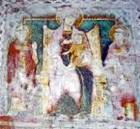
Crucifixion with donors (early 14th century)
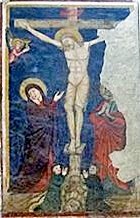
Tree of life (ca. 1300)
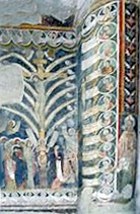
Frescoes attributed to Pietro di Puccio (late 14th century)
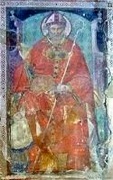
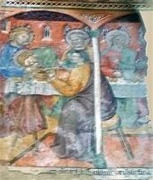
Two frescoes on the counter-facade are attributed to Pietro di Puccio:
-
✴St Juvenal enthroned with donor, to the right of the portal (and of the small door that leads to the campanile); and
-
✴the Last Supper, at the extreme right (on what is actually the right wall of the baptistery on the left wall).
First Column on the Left
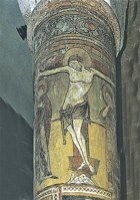


The frescoes (13th century) on the upper part of the column are attributed to the Maestro dei SS Severo e Martirio. They depict:
-
✴the Crucifixion with the Virgin and St John the Evangelist;
-
✴St Francis;
-
✴St Dominic; and
-
✴ a female saint (not illustrated).
Those on the lower part of the column include a fresco (late 14th century) of St William of Malavalle holding a rosary.
First Column on the Right
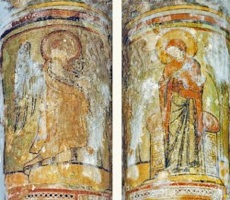
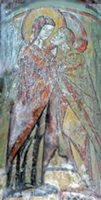
The damaged frescoes (13th century) on the upper part of the column are also attributed to the Maestro dei SS Severo e Martirio They depict:
-
✴the Annunciation;
-
✴the Visitation (illustrated); and
-
✴a bishop saint, perhaps St Juvenal (not illustrated).
Those on the lower part of the column include a lovely fresco (14th century) of St Michael killing the dragon.
Left Wall
Four saints (late 14th century)
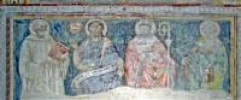
This fresco in the 2nd bay, of which only the upper part of survives, is attributed to Pietro di Puccio. It depicts:
-
✴St William of Malavalle (holding a rosary and carrying the Rule of his Order);
-
✴St John the Baptist;
-
✴St Juvenal; and
-
✴St Lawrence (with the grill on which he was martyred).
Assumption of the Virgin (14th century)
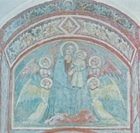
St William of Malavalle (15th century)
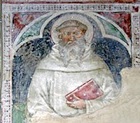
Madonna del Latte (ca. 1300)
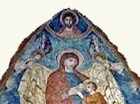
Right Wall
Madonna and Child enthroned with saints (ca. 1300)

Crucifixion with the instruments of the Passion (14th century)
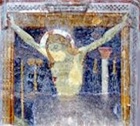
Madonna and Child enthroned with saints (14th century)
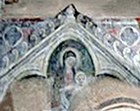
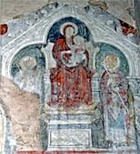
The larger of these two frescoes in the 4th bay, which is dated by inscription to 1312, is attributed to Maestro della Madonna di San Brizio. It depicts the Madonna and Child with under a fictive aedicule, with SS Sabinus and Juvenal and donors below. The more fragmentary fresco to the left of it probably had the same format and might well have been by the same artist.
Head of an angel (13th century)
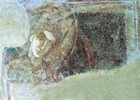
St Bernardino of Siena (15th century)
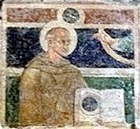
Annunciation and Nativity (14th century)
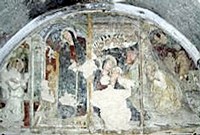
This damaged fresco under the aedicule on the right wall (to the right of the side entrance) is attributed variously to Ugolino di Prete Ilario or Giovanni di Buccio di Leonardello.
Left Pilaster
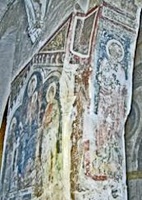
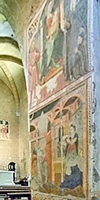
Outer side of the left pilaster Outer side and arch of the right pilaster
(looking towards the high altar) (looking away from the high altar)
The frescoed pilasters above the steps were built as part of the extension of the church in the late 13th century.
Madonna del Latte with saints (1399)
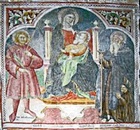
Annunciation (ca. 1380)
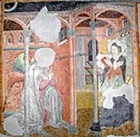
Right Pilaster
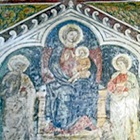

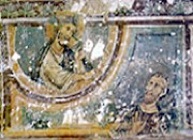
The three frescoes on the right pilaster are attributed to the Maestro della Madonna di San Brizio:
-
Madonna and Child with saints (late 13th century)
-
This fresco on the outer side of the pilaster depicts the Madonna and Child with SS Peter and John the Evangelist and a kneeling donor.
-
St Agnes
-
This damaged fresco is under the arch. (The figure is tentatively said to be St James in the guide book of the church. However, St Agnes is in fact identified by inscription and carries her usual attribute, the Lamb of God.
-
Conversion of St Paul (late 13th century)
-
This lovely fresco of Christ appearing to St Paul on the inner side of the pilaster depicts Christ above a rainbow in the top right hand corner appearing to a startled St Paul. (Its relationship to a fresco of St Bernardino on the right wall was discussed above.)
Apse
St Catherine of Alexandria (15th century)
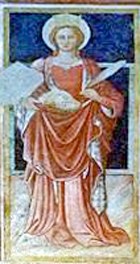
St William of Malavalle (14th century)
This faded fresco is to the right of the steps that lead to the apse. The frescoed inscription (13th century) below, which recites the Ten Commandments, was restored in 1989.
Read more:
C. Fratini, “Pittura e Miniatura ad Orvieto dal XII al XIV Secolo”, in
G. della Fina and C. Fratini (Eds), “Storia di Orvieto: Medioevo”, (2007) Pisa, p. 457-98
V. Benucci, “L’ Antica Chiesa di San Giovenale in Orvieto”, (2000) Orvieto (available in the church)
Return to Main page.
Return to Monuments of Orvieto.
Return to Walk II.

